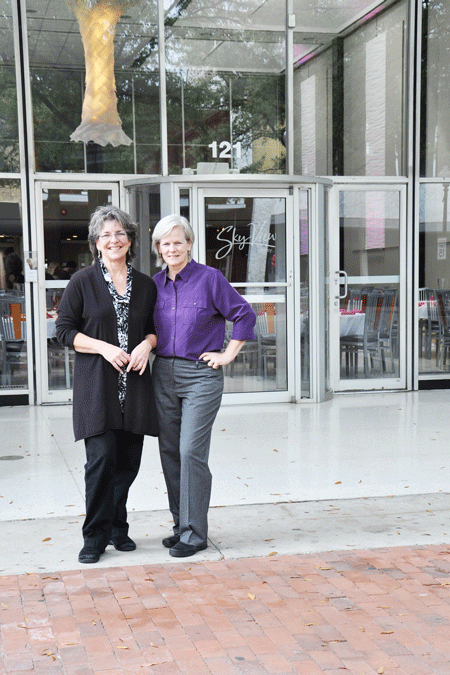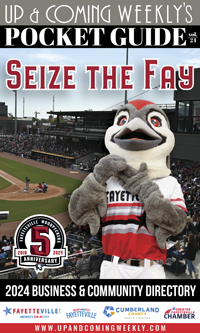 Twenty years ago this month, Jan Johnson and Pat Wright were employed at Fayetteville Technical Community College. They did videography work for the school, and after several people asked them to do projects for them not associated with the school, they decided to venture out and, in their words, “stick their toes into the water and start moonlighting.”
Twenty years ago this month, Jan Johnson and Pat Wright were employed at Fayetteville Technical Community College. They did videography work for the school, and after several people asked them to do projects for them not associated with the school, they decided to venture out and, in their words, “stick their toes into the water and start moonlighting.”
It wasn’t long after that, that they opened their first office in their home on Oct. 12, 1993. Johnson had young children at the time, and found the convenience of working at home to be beneficial. Their business quickly took off, and, after seven years, they had outgrown their home office and began looking for new digs for their growing company, Moonlight Communications.
The pair found their place while doing what they do best, making videos. They were hired by Robin Kelly-Legg, then the director of the Old Fayetteville Association, to follow Robert Marvin, the designer of the Marvin Plan to revitalize downtown, to other city’s that had successfully revitalized their downtowns. Footage from the visits became the video that really ignited the fire of revitalization of downtown when it was shown to the city council and community leaders at the Crown Arena.
“I guess you could say we drank the Kool Aid and started looking for buildings downtown,” said Johnson.
They were encouraged in their decision by Eric Lindstrom, local architect and one of the first people to move into downtown at the start of the revitalization. Their opportunity to move downtown came four years later in 1999.
“All good things come to those who wait,” continued Johnson. “When we bought our building in 1999, you could have fired a gun through downtown and not hit anybody.”
The building they purchased was the original home of the Rainbow Restaurant, which is now located on Ramsey Street. According to Wright, who researched the building in great detail, the restaurant opened in the building in 1937 and moved out in 1974. The building stood empty for 25 years waiting for someone to restore it.
Lesser women would have run screaming from the job, but Wright and Johnson embraced it. A lot of the old historic buildings had burned down during the derelict years. Homeless people would go inside the buildings and start fires in them for warmth. The floors of the Rainbow building had burn marks, but fortunately the building remained largely intact.
Every weekend for a year, the two would put on their work clothes and their masks and grab their tools and head downtown. They applied for and received state and federal historical tax credits to rehab the building. Those credits put exacting demands on what could and could not be done. Great attention to detail was important in order to maintain the historical integrity of the building. The three-story building had structural damage, and in fact, the floors in the back section of the building had collapsed. The enterprising women painted lines on the floors to indicate the sound paths they could follow while working. They would carry the debris from the front of the building and pour it two floors down to the ground floor.
They completely gutted the structure and were amazed at the beautiful pieces of the building they uncovered as they tore away years of construction. They were not alone in the project, as is the case in all that they have done, they are quick to call attention to the people who helped them along the way. Lindstrom and Greg King, another downtown dweller, were on speed dial and always available to lend them a hand. Lindstrom was of particular importance because of his building knowledge.
“We would call and he always helped us out,” said Wright.
After pouring blood, sweat and tears into it, the two ensured that the building was put on the National Registry of historic buildings. With that designation, it cannot be torn down. It cannot be altered. This is important to the two, who are members of Preservation North Carolina.
“We take the preservation of these old buildings very seriously,” said Johnson. “We love these buildings and what they represent. So many of them have been lost.”
The three-story building is a multi-use structure. The third floor is a rental loft, the second floor is home to their business and the first floor houses The Rainbow Room, which is an event facility. Initially the bottom floor was to become retail space, but after 9/11, business stalled and the two decided to create another business.
“We made it affordable for people to come downtown and have parties. We brought a lot of people downtown to use the facility and while they were here, they saw all the other things downtown had to offer like the Cameo and Pierro’s. People started seeing that things were changing downtown.”
By creating businesses downtown, the two felt they gained credibility with their downtown neighbors.
“They saw that we were not just here to make a living, but rather we were going to put our money where our mouths were,” said Wright.
The two proudly look at the changes downtown and are happy to be a part of it. They see downtown on a constant upward trajectory.
“It’s unbelievable the amount of money that has been invested in downtown,” said Wright. “The way a downtown grows is by making changes in its businesses. The core businesses remain, while other businesses may change, but there isn’t a vacuum.”
They had an opportunity to change the course of another old building when what is now known as Skyview on Hay came available. The building, located on the Market House end of Hay Street, had been a series of bars before the ATF closed it down. Wright and Johnson had looked at the building earlier, but the price was not right. With its closing, the building came back on the market, and as they have seen repeatedly, everything came together to make it a viable possibility.
The building, which was initially constructed as a BB&T, had fallen into disrepair. The architectural qualities, which had defined the building when it was first built, had been covered up and hidden from sight. As was the case with the Rainbow building, the duo did a lot of research finding pictures of the original interiors of the building in order to bring the building back to its former glory.
“The building was built in 1965 and it was an absolutely gorgeous place,” said Wright. “It had been used for a number of businesses, but most recently was operated as a series of bars.”
Johnson and Wright understand the importance of mixed use downtown and the importance of entertainment venues, but they are also advocates of responsible business ownerships and community partnerships. That wasn’t the case with the bars that operated in the building. They saw the effects of the bars on downtown with fights in the parking lots, beer cans littering the street and graffiti on their beloved historic buildings.
“It was really destroying the feeling of security that we cherish in downtown,” said Johnson. “One night an alarm went off in the Rainbow Room, and we came downtown and there were police everywhere and people pouring out of the bars, fighting.”
Shortly after that, the ATF shut down the bar in 2009 and the ladies purchased the building on July 1, 2010. Unlike the previous rehab, they paid others to do the work, but they lovingly oversaw it and faithfully restored it to the way it had been when BB&T operated in it. The restoration took about eight months and included putting new roofs on three sections of the building, scraping black paint off of the skylights, tearing down drywall that covered beautiful wood work and classic glass work.
Three months into the process of the turning the establishment into another event facility, they had already booked their first event. They noted that the people throwing the party were so impressed with what had been done at that point that they booked the unfinished facility. The first event was on Feb. 11. 
The three-story facility is divided into several event spaces, with three catering kitchens. The first floor is divided into two separate meeting spaces, with the main ballroom facing Hay Street. The second floor has several smaller meeting spaces. A signature component of the facility is the Zen garden, which ties the front portion of the building with the back. The garden, which was an original feature of the building, was lovingly restored by Wright and Johnson.
Earlier this year, the third floor was opened as Level 3, an offshoot of Moonlight Communications. The state-of-the-art video studio is a multi-use facility that complements their professional business, but also their event business.
“It’s the only studio of its kind in the city,” said Wright.
The partners considered themselves blessed in that their profession enables them to tell the community’s story, but that their passion also helps them shape their community.
“One of our mottoes is to think and dream big,” said Wright, reflecting on the past 20 years of business and downtown preservation. “You never know what the universe will put in your path, you’ve got to be open to it..”
Photo: Jan Johnson (left) and Pat Wright (right) stand in front of Skyview on Hay one of the two buildings they have renovated. The Rainbow Room (opposite page) was their first.

 How to resolve AdBlock issue?
How to resolve AdBlock issue? 








